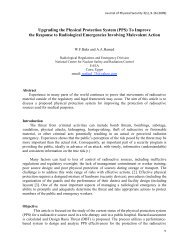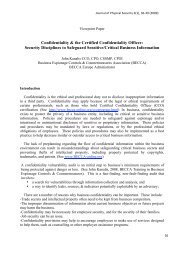PDF - The Journal of Physical Security - Argonne National Laboratory
PDF - The Journal of Physical Security - Argonne National Laboratory
PDF - The Journal of Physical Security - Argonne National Laboratory
You also want an ePaper? Increase the reach of your titles
YUMPU automatically turns print PDFs into web optimized ePapers that Google loves.
<strong>Journal</strong> <strong>of</strong> <strong>Physical</strong> <strong>Security</strong> 4(2), 10-29 (2010)6. Probability <strong>of</strong> blast protection<strong>The</strong> significance <strong>of</strong> a design curve in Figure 13 is that the associated structural component is protectedfrom any blast for which the TNT equivalent mass and stand<strong>of</strong>f distance gives a point lying under thecurve. Accordingly, the probability that the component will withstand a blast is obtained by integratingthe probability function over all points (m,r) that lie underneath the curve.<strong>The</strong> design curves <strong>of</strong> Figure 13 are almost linear through the portion <strong>of</strong> the region they occupy where theprobability function is zero. Linear fits to the curves in this portion are shown superimposed on thecontour diagram for the probability function (<strong>of</strong> Figure 4), in Figure 14. <strong>The</strong> curves are shown only in therange <strong>of</strong> m and r where the probability function is nonzero.Equivalent TNTmass (lbs)Stand<strong>of</strong>f distance (feet)Figure 14. Design curves <strong>of</strong> Figure 13 superimposed on the probability function contour diagram <strong>of</strong> Figure 4.Again, the solid design curve is chosen to pass through 8 psi and 170 psi msec for a natural oscillation angularfrequency <strong>of</strong> 56 sec -1 , whereas the dashed curve is chosen to pass through 16 psi and 185 psi msec, with the samenatural oscillation angular frequency <strong>of</strong> 56 sec -1 . <strong>The</strong> probability function F mr (m,r) is given by eq. [5] as the product<strong>of</strong> truncated normal distributions in m and r.For both design curves, it is seen that the maximum <strong>of</strong> the probability function lies below design curves.It is also seen that more <strong>of</strong> the probability function is below the dashed curve (16 psi, 185 psi msecdesign) than below the solid curve (8 psi, 170 msec). Thus, it would be expected that the confidencelevel for protection for the former would be higher than for the lower.For the design curves depicted in Figure 14, the probability P protected that the structural component will beprotected against a blast isr ma smaller <strong>of</strong> {m design (r), m max }P protected = ∫dr ∫F mr (m,r) dm [27]r min m min26





